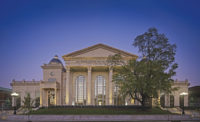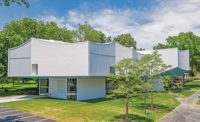The Fisher Center for Performing Arts
Nashville, Tennessee
Best Higher Education/Research
Submitted By: R.C. Mathews Contractor
Owner: Belmont University
Lead Design Firm: Earl Swensson and Associates
General Contractor: R.C. Mathews Contractor
Civil Engineer: Catalyst Design Group
Structural Engineer: Ross Bryan Associates
MEP Engineer: I.C. Thomasson Associates
Subcontractors: Akustiks; Theater Projects; CDC; RBLD; Hodgson Douglas; Inman Food Services; Smith Seckman Reid
The team behind the Fisher Center for the Performing Arts at Belmont University in Nashville had to build a space as beautiful to the ear as it is to the eye.
Completed in September 2021, the center features two recital halls, a 12,000-sq-ft grand lobby and a 1,700-seat performance hall.
“While the architectural grandeur is on display, much more is hidden behind the floors, walls and ceilings,” says Russell Todd, principal of acoustic design company Akustiks. In “a multi-use hall where adjustable acoustics are deployed to dampen sound for amplified events or stored to generate acoustic resonance for a grand opera or orchestra concert, the complexity of systems is multiplied.”
Effort was spent on coordinating systems, materials, connections and sound testing, he says.
A concrete structure was used to build the performance hall from the foundation up to the third balcony, and steel trusses were used for the attic and roof construction. This provided acoustic mass and optimal sight lines, maximizing floor-to-ceiling space.
“The complexity of formwork geometry, reinforcing profiles, miles of in-slab rough-ins and minimal tolerances for finishes demanded precise pre-planning and coordination,” says Scott Morgan, senior project manager for R.C. Mathews. “Each balcony raker beam, column and seating area had to be meticulously handcrafted for each balcony condition. The building’s geometry made it very difficult to capture all of its elements on 2D drawings.”
The concrete was modeled in 3D, and custom line drawings were produced to anticipate potential conflicts. Laser scanning was used to check placements.

Photo: Hall + Merrick
When it was discovered that 192 decorative metal ceiling panels would resonate just like a tuning fork in the space, R.C. Mathews came up with a creative solution: coating the panels in truck bed liner material, successfully eliminating the resonance, and ensuring that only music emanates from the Fisher Center.

Photo: Hall + Merrick





Post a comment to this article
Report Abusive Comment